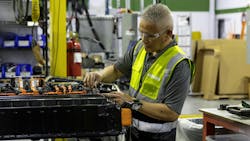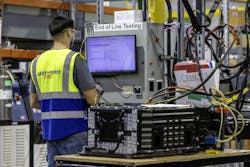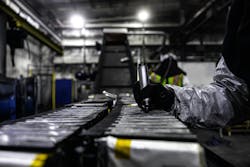Cox drills into EV battery maintenance, life cycles at OKC site
OKLAHOMA CITY—A century ago, Oklahoma routinely led the U.S. in oil production. Now in the state’s capital, Oklahoma City, Cox Automotive hopes to jump-start the adoption of what many see as oil’s replacement: Electric vehicle batteries. But first, they have to drill down to discover the many questions surrounding the energy storage technology, like how long they last, how to fix them, and what to do with them when they’re spent.
And finding answers to those questions is exactly what’s being done at the company’s EV Battery Solutions facility, where Fleet Maintenance was invited in late August. The Oklahoma plant is the crown jewel of Cox Automotive’s EV service network, with the ability to handle end-to-end service, storage, distribution, repair, remanufacture, and recycling.
Cox acquired the facility with its acquisition of Spiers New Technologies in 2021, a move to immediately improve its understanding of EV battery lifecycle management. Earlier in that year, Cox bought Dickinson Fleet Services, a leader in commercial vehicle mobile maintenance. Both moves intimate where vehicle maintenance is headed: zero emissions—and zero miles traveled by customers to receive service. Cox predicts that “by 2033, half of all new vehicles sold will be an EV.”
That seems a ways off, but the engineers and production specialists know it isn’t, as their constant movement implied. Even when the building was quieted for the media tour to visit, the place hummed with activity from the electrical lab to the recycling production lines, all dedicated to the details of EV battery management and function throughout their life cycles.
“In this rush to production and adoption, once that vehicle is out in the wild, how it’s going to be taken care of, what happens when an unexpected failure occurs in the battery pack, is something we've specialized in,” said Lea Malloy, AVP of EV Battery Solutions by Cox Automotive.
Malloy said Cox’s “expertise in diagnostics” is helping figure out how to better repair and refurbish EV batteries and ultimately extend the life of the battery. Considering the economic and environmental costs of producing these batteries, Cox wants to prevent “replacing every sick battery,” she said.
And Malloy noted that because EV batteries specifically are so heavy, moving them around adds to their serviceability cost. “And in fact, that portion of the logistics cost is getting higher and higher,” she said.
Spiers originally chose Oklahoma City due to its central location in the U.S. and its impact on shipping costs, which helps with overall logistics.
This is why “being centrally located is a huge advantage, to cover all the corners [of the U.S.]” explained Hilal Ismail, sr. director of Operations. This brings the facility’s services, from battery diagnostics to recycling, closer to the fleets working to electrify their assets.
Arrival and testing
For the Oklahoma facility, much of their work is on the battery module level, said Tim Harris, director of operations management. This means using ALFRED, the company’s battery platform management program, to display their progress on clients’ battery projects, whether that’s an OEM whose batteries undergo a recall or a dealer with a customer who needs a battery repair.
When a misbehaving battery arrives at the Oklahoma City EV Battery Solutions facility, diagnostic work comes before opening up the battery pack. As with diagnosing a truck, root-cause analysis is key, said Brandon Carter, root cause engineering manager. This allows Cox Automotive to leverage its battery learnings in future repairs both in the facility and in the field.
Next, technicians may need to use an oscillating cutting tool to go around the perimeter lid of the battery pack to reveal the battery modules within. This allows Cox Automotive to run various tests to see which module is the problem and install a new one, ensuring that the replacement matches its neighbors before resealing the pack, Carter emphasized.
As for what kinds of tests Cox Automotive uses to determine battery health, these are developed in the facility’s electronics lab, which Connor Taylor, manager of electrical engineering, and Sarah Hake, manager of product operations, founded in 2018. But why build their testing equipment when there are store-bought versions available?
“It's obviously expensive, but for the testing that we need to do on some of these batteries, sometimes there just isn't a commercial option, so we have to build equipment for those cases,” Taylor noted.
Read more: Analysis: The dark side of electrification
As an example, one of the tests Taylor needed to run required charging and discharging the vehicle battery while measuring voltage, current, and temperature, which would allow him to find out which modules were functioning. But some of the newer EV batteries feature 800V architecture or higher, while most commercial source measurement units on the market max out at 600V. Not to mention the cost of these units alone.
“The problem was scale,” Taylor recalled. “At the time, we calculated that we needed 2,000 channels, and we were quoted $1,000 a channel.”
But by designing their own equipment, Cox Automotive’s electrical lab was able to work that $2 million price down to $320,000, Taylor reported. This approach also allows the facility to focus on safety tailored toward their operations. For example, Hake explained how the electrical lab created their own specialized temperature test devices for a particular hybrid battery line, partly to increase safety at the facility.
“Because we have to remanufacture these [batteries], we want to make sure that everybody's safe, including ourselves, our equipment, the battery, and the operators,” Hake said. “We need to keep a close eye on that temperature – as the temperature starts to creep up on these guys, that's usually a good indication that it's going to be a bad module or it could become a dangerous module.”
Granting batteries their second life
However, Cox Automotive’s EV Battery Solutions facility doesn’t only handle diagnostics and testing. It is the only Cox Automotive location that handles the battery recycling process. By doing so, the company can distill black mass, a mixture of cobalt and nickel manganese, that can be blended into new components from old batteries.
“This is sold out at commodity pricing to other refiners who will make the precursors to build batteries,” Harris stated. “Nothing gets landfilled. All the non-ferrous plastics get shipped to recycling.”
Cox Automotive uses a dry process to do this, and has recovered a million pounds of black mass from 3.5 million pounds of batteries which have gone through the recycling process, Malloy said during the media tour.
The first step of this process is to take apart the battery packs and depower the modules slated for recycling, which can take 12-14 hours.
“By the time they reach us at the actual shredding stations, we've taken several steps to make sure these batteries are inert,” explained Tiger Parish, manager of Battery Recycling. “We're not going to have any issues with them.”
Watching this process through a window to the production floor feels a bit like watching astronauts building rockets on Mars, given the billowing safety suits and cylindrical helmets the shredders wore. These workers send the battery module up a conveyor belt, where it goes through shredding equipment until the battery pieces are the right size. Then these pieces go through a series of ring mills to pulverize what remains, before everything runs through separators, which sort out the plastic, aluminum foil, and black mass. The entire process is purely mechanical and takes roughly three to four minutes, Parish said.
“Some of the metals and the plastics are separated pneumatically,” Parish added. “We use airflow to separate some of those bigger materials from the heavier ones.”
Through this process, the Oklahoma City location tries to process an average of 1,000 modules per week. However, this productivity can vary based on the weather and air quality, as the company wants to avoid having too much particulates and humidity in the air.
The Cox Automotive’s tour of its Oklahoma facility was detailed and extensive, but the engineers and operations staff there hardly scratched the surface of their expertise for the few hours we spent there. While the tour displayed the effort and ingenuity behind every aspect of transitioning to electrical powertrains, it also showed how far the industry has to go in terms of understanding these critical components.
“The OEMs, in my opinion, are still viewing EV battery caretaking as if it were a combustion part, like a transmission, and expecting scale and a centralized distribution of parts, which doesn't always work because of the cost,” Malloy concluded. “So I think the whole industry is learning how to think differently, and a lot of innovation is required to be successful because we're in this transition period.”
About the Author

Alex Keenan
Alex Keenan is an Associate Editor for Fleet Maintenance magazine. She has written on a variety of topics for the past several years and recently joined the transportation industry, reviewing content covering technician challenges and breaking industry news. She holds a bachelor's degree in English from Colorado State University in Fort Collins, Colorado.



